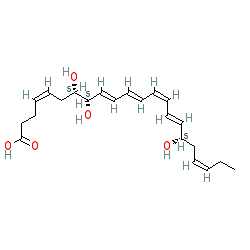|
Abbreviated name: RvD1
Synonyms: 7S,8R,17S‐trihydroxy‐4Z,9E,11E,13Z,15E,19Z‐docosahexaenoic acid
Compound class:
Metabolite or derivative
Comment: This is a D (docosahexaenoic acid) series resolvin. There is some ambiguity in the literature and on online resources as to the exact stereochemistry of resolvin D1. The structure shown here is the same as that shown in the PubChem entry linked to above, while other common representations include CID 44251266 and CID 16061135.
Ligand Activity Visualisation ChartsThese are box plot that provide a unique visualisation, summarising all the activity data for a ligand taken from ChEMBL and GtoPdb across multiple targets and species. Click on a plot to see the median, interquartile range, low and high data points. A value of zero indicates that no data are available. A separate chart is created for each target, and where possible the algorithm tries to merge ChEMBL and GtoPdb targets by matching them on name and UniProt accession, for each available species. However, please note that inconsistency in naming of targets may lead to data for the same target being reported across multiple charts. ✖ |
|
|||||||||||||||||||||||||||||||||||
| References |
|
1. Bang S, Yoo S, Yang TJ, Cho H, Kim YG, Hwang SW. (2010)
Resolvin D1 attenuates activation of sensory transient receptor potential channels leading to multiple anti-nociception. Br J Pharmacol, 161 (3): 707-20. [PMID:20880407] |
|
2. Bäck M, Powell WS, Dahlén SE, Drazen JM, Evans JF, Serhan CN, Shimizu T, Yokomizo T, Rovati GE. (2014)
Update on leukotriene, lipoxin and oxoeicosanoid receptors: IUPHAR Review 7. Br J Pharmacol, 171 (15): 3551-74. [PMID:24588652] |
|
3. Chiang N, Fredman G, Bäckhed F, Oh SF, Vickery T, Schmidt BA, Serhan CN. (2012)
Infection regulates pro-resolving mediators that lower antibiotic requirements. Nature, 484 (7395): 524-8. [PMID:22538616] |
|
4. Clish CB, O'Brien JA, Gronert K, Stahl GL, Petasis NA, Serhan CN. (1999)
Local and systemic delivery of a stable aspirin-triggered lipoxin prevents neutrophil recruitment in vivo. Proc Natl Acad Sci USA, 96 (14): 8247-52. [PMID:10393980] |
|
5. Codagnone M, Cianci E, Lamolinara A, Mari VC, Nespoli A, Isopi E, Mattoscio D, Arita M, Bragonzi A, Iezzi M et al.. (2018)
Resolvin D1 enhances the resolution of lung inflammation caused by long-term Pseudomonas aeruginosa infection. Mucosal Immunol, 11 (1): 35-49. [PMID:28422188] |
|
6. Colby JK, Abdulnour RE, Sham HP, Dalli J, Colas RA, Winkler JW, Hellmann J, Wong B, Cui Y, El-Chemaly S et al.. (2016)
Resolvin D3 and Aspirin-Triggered Resolvin D3 Are Protective for Injured Epithelia. Am J Pathol, 186 (7): 1801-1813. [PMID:27171898] |
|
7. Davenport AP, Alexander SP, Sharman JL, Pawson AJ, Benson HE, Monaghan AE, Liew WC, Mpamhanga CP, Bonner TI, Neubig RR et al.. (2013)
International Union of Basic and Clinical Pharmacology. LXXXVIII. G protein-coupled receptor list: recommendations for new pairings with cognate ligands. Pharmacol Rev, 65 (3): 967-86. [PMID:23686350] |
|
8. Fiore S, Maddox JF, Perez HD, Serhan CN. (1994)
Identification of a human cDNA encoding a functional high affinity lipoxin A4 receptor. J Exp Med, 180 (1): 253-60. [PMID:8006586] |
|
9. Fiore S, Serhan CN. (1995)
Lipoxin A4 receptor activation is distinct from that of the formyl peptide receptor in myeloid cells: inhibition of CD11/18 expression by lipoxin A4-lipoxin A4 receptor interaction. Biochemistry, 34 (51): 16678-86. [PMID:8527441] |
|
10. Gronert K, Martinsson-Niskanen T, Ravasi S, Chiang N, Serhan CN. (2001)
Selectivity of recombinant human leukotriene D(4), leukotriene B(4), and lipoxin A(4) receptors with aspirin-triggered 15-epi-LXA(4) and regulation of vascular and inflammatory responses. Am J Pathol, 158 (1): 3-9. [PMID:11141472] |
|
11. Krishnamoorthy S, Recchiuti A, Chiang N, Yacoubian S, Lee CH, Yang R, Petasis NA, Serhan CN. (2010)
Resolvin D1 binds human phagocytes with evidence for proresolving receptors. Proc Natl Acad Sci USA, 107 (4): 1660-5. [PMID:20080636] |
|
12. Park CK, Xu ZZ, Liu T, Lü N, Serhan CN, Ji RR. (2011)
Resolvin D2 is a potent endogenous inhibitor for transient receptor potential subtype V1/A1, inflammatory pain, and spinal cord synaptic plasticity in mice: distinct roles of resolvin D1, D2, and E1. J Neurosci, 31 (50): 18433-8. [PMID:22171045] |
|
13. Southern C, Cook JM, Neetoo-Isseljee Z, Taylor DL, Kettleborough CA, Merritt A, Bassoni DL, Raab WJ, Quinn E, Wehrman TS et al.. (2013)
Screening β-Arrestin Recruitment for the Identification of Natural Ligands for Orphan G-Protein-Coupled Receptors. J Biomol Screen, 18 (5): 599-609. [PMID:23396314] |
|
14. Takano T, Fiore S, Maddox JF, Brady HR, Petasis NA, Serhan CN. (1997)
Aspirin-triggered 15-epi-lipoxin A4 (LXA4) and LXA4 stable analogues are potent inhibitors of acute inflammation: evidence for anti-inflammatory receptors. J Exp Med, 185 (9): 1693-704. [PMID:9151906] |
|
15. Zhang MJ, Sansbury BE, Hellmann J, Baker JF, Guo L, Parmer CM, Prenner JC, Conklin DJ, Bhatnagar A, Creager MA et al.. (2016)
Resolvin D2 Enhances Postischemic Revascularization While Resolving Inflammation. Circulation, 134 (9): 666-680. [PMID:27507404] |








